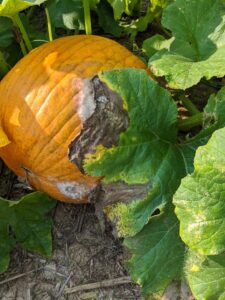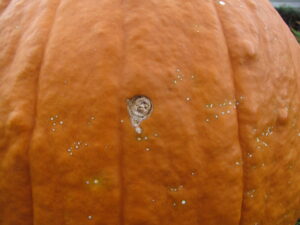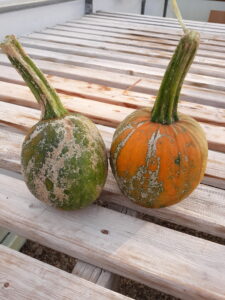In the next month, many growers will start to plant pumpkins. This article will introduce aspects of disease management of pumpkins prior to the growing season.
The information below is discussed under several of the most common diseases of pumpkins in Indiana. The objective of this article is to discuss what diseases are more likely to be important in Indiana and when to manage these diseases. A fungicide schedule is available here. General fungicide recommendations for all vegetables can be found at mwveguide.org. Contact Dan Egel for a hard copy of these or other extension bulletins.
Black rot-this fungal disease can cause dark watery lesions on pumpkin fruit and, upon occasion, brown lesions on leaves. When this disease occurs on fruit it is known as black rot; when the disease occurs on foliage, it is known as gummy stem blight although it is caused by the same organism. Black rot is more common on squash and pumpkin; gummy stem blight is more common on cantaloupe and watermelon.
The fungal organism that causes black rot can survive in crop residue, so crop rotation and fall tillage are critical for the control of black rot. Fungicides should start when pumpkin plants have become well established and begun to grow into a small upright ‘bush’.
Plectosporium blight-pumpkin fruit or foliage affected with Plectosporium blight appear speckled with a small, light-colored scars (Figure 1). Lesions may appear spindle shaped. Lesions are more common on the handle of the pumpkin where they may make the fruit unmarketable.
The fungal organism that causes Plectosporium blight may survive in crop residue. Therefore, crop rotation and fall tillage is important. The occurrence of Plectosporium blight is sporadic; however, when it does occur, it can be a serious and difficult to control disease. If the disease threatens, regular fungicide applications such as described under black rot may be appropriate.
Phytophthora blight is consistently one of the most important diseases of pumpkin in Indiana. Phytophthora blight causes soft, rotten areas on fruit that may be covered in a white mold in moist weather (Figure 2). Vines and leaves may also be affected. The fungus like organism that causes Phytophthora blight survives well in soils and has a large host range. Therefore, crop rotation may not be effective in control of this disease. Phytophthora blight is an important disease of all cucurbits and is described in more detail here.

Figure 2. Phytophthora blight has caused mold covered lesion on the surface of this pumpkin as well as necrotic lesions on the leaves.
The fungus like organism that causes Phytophthora blight is favored by wet soils and heavy rains. Water that stands in pools, whether in fields are on plastic, favor the survival and spread of Phytophthora blight. Select fields, if possible, that are well drained and do not have a history Phytophthora blight.
The fungicides that are effective against Phytophthora blight are often not effective against other fungal diseases. Fungicides should start at or close to bush stage if not before.
Powdery mildew is perhaps the most easily recognized pumpkin disease that occurs in Indiana. A white, talc-like growth may be detected on leaves and stems. Although fruit are usually not directly affected, severe powdery mildew may cause the stems (handles) to become prematurely, brown and whither.
Several excellent pumpkin varieties have partial resistance to powdery mildew. Most growers find it necessary to use fungicides to manage powdery mildew. Systemic fungicides are recommended since powdery mildew colonies can be on either side of the leaf. Start fungicides at the bush stage-when the plant has grown upright and right before it starts to vine. At this stage, the canopy inside the ‘bush’ maintains the high humidity which is perfect for powdery mildew.
Bacterial spot of pumpkin-this is an important and difficult to control disease of pumpkin in Indiana. (Officially, the disease name is Xanthomonas leaf spot.) Lesions of bacterial spot of pumpkin leaves can be recognized by the light brown, almost angular nature of the lesions. These lesions do not cause economic damage. However, leaf lesions may harbor bacteria that may splash onto fruit where they may cause scab-like lesions which lower the marketability of the fruit (Figure 3). Occasionally, lesions may become secondarily infected by fungi, causing a large whole well into the flesh of the pumpkin.

Figure 3. Several necrotic lesions caused by bacterial spot of pumpkin can be observed here. One lesion is much larger and has probably been infected by a secondary fungus.
The bacteria that cause bacterial spot of pumpkin may survive on crop residue. Therefore, crop rotation and fall tillage are important in the management of this disease. The bulletin described above discusses the use of copper products when the fruit are softball sized or earlier if lesions are observed on leaves.
Pumpkin production in Indiana can be affected by several viral diseases. These diseases are vectored or spread by aphids. Insecticides are often not effective in stopping the spread of viruses because aphids can transmit the diseases in seconds. The most effective management for virus diseases of pumpkin in Indiana is to avoid late planted pumpkins. In southern Indiana, planting pumpkins by about mid-June or sooner will lessen the severity of virus symptoms. This is because earlier planted pumpkins will set fruit before viruses because a problem.
